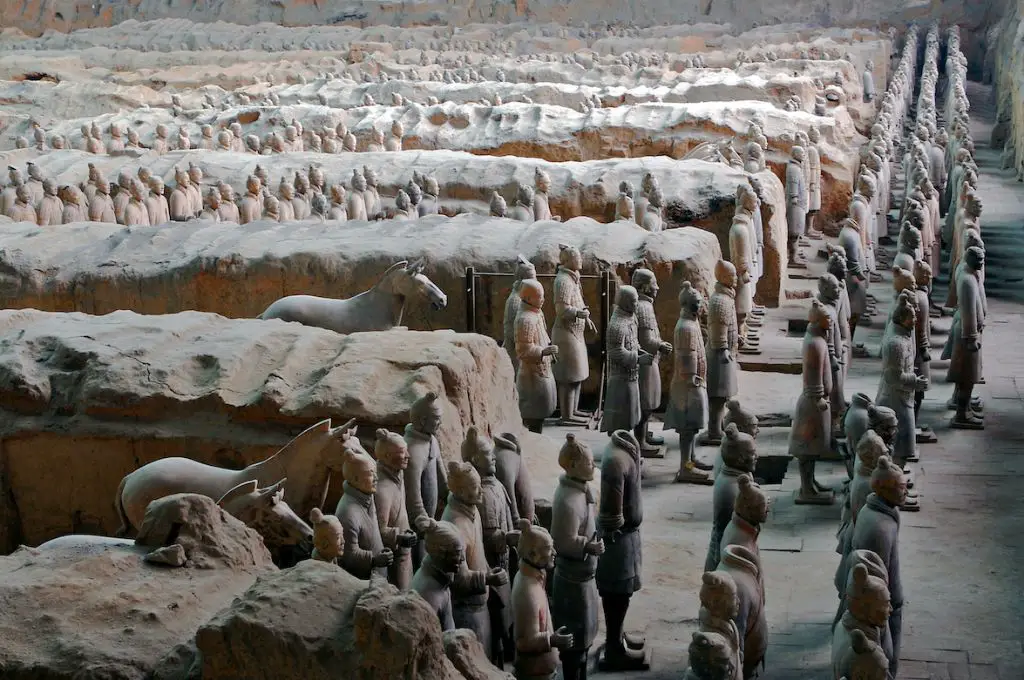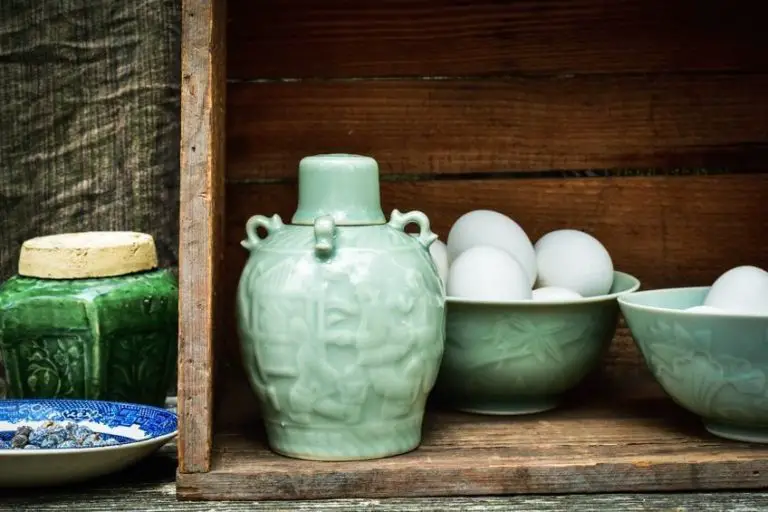How Many Chinese Clay Soldiers Are There?
The Terracotta Army, also known as the Terracotta Warriors, is one of the most significant archaeological discoveries of the 20th century. This army of thousands of life-size clay soldier figures was discovered in 1974 by local farmers near the Mausoleum of the First Qin Emperor in Xi’an, China. The figures date back over 2,200 years to around 210 BCE when they were created under the order of Emperor Qin Shi Huang, the first emperor of a unified China. The purpose of this enormous funerary art collection was to continue protecting the first emperor in the afterlife. The details and individuality of each soldier figure are astounding, with variety in clothing, hairstyles, facial features, and weapons. The Terracotta Army provides incredible insight into the military power and artistic sophistication of ancient China. Since its discovery, the site has been protected and undergoes continual restoration and research efforts. The Terracotta Warriors have become one of China’s top tourist attractions and an iconic symbol of ancient Chinese artistic achievement.
The First Emperor’s Mausoleum
The Terracotta Army was discovered in 1974 by local farmers drilling a water well around 1.5 km east of the Mausoleum of the First Qin Emperor near Xi’an, China (Mausoleum of the First Qin Emperor). The mausoleum complex was built during the third century BCE for Qin Shi Huangdi, the first emperor of unified China. Spanning over 56 square km, the mausoleum contains not only the famous Terracotta Warriors, but also palaces, towers, and other shrines. The purpose of such an elaborate mausoleum complex was to continue the emperor’s reign even after his death. Ancient Chinese tradition dictated that everything the emperor had in life should follow him into the afterlife. Thus, the mausoleum was filled with artifacts from his life, including the Terracotta Army which was created to protect his tomb.
The Excavation Process
The Terracotta Army was discovered in 1974 by local farmers drilling wells near Xi’an, China. This chance discovery would lead to one of the most significant archaeological excavations of the 20th century.
The farmers uncovered fragments of terracotta figures and alerted Chinese archaeologists to the site. Systematic excavation began shortly after, led by director Zhao Kangmin of the Shaanxi Provincial Institute of Archaeology. Archaeologists discovered the pits containing the Terracotta Army were part of the much larger burial complex built for China’s First Emperor, Qin Shi Huang.

From 1974 to 1984, archaeologists excavated Pit 1, which contained the main army. Over 8,000 soldiers, 130 chariots, and 670 horses were carefully uncovered in this pit alone. Excavation of Pit 1 was completed in 1984. Further excavations revealed more pits beside Pit 1 containing figures and artifacts related to the army. Pit 2 contained cavalry and infantry units along with war chariots. Pit 3 was discovered in 1976 and completed excavation in 1989, uncovering 68 officers and soldiers.
Recent excavations occurred as recently as 2009. Archaeologists discovered Pit 199, a smaller pit close to the location of the main army in Pit 1. Over 200 figures were uncovered in Pit 199, composed of armored soldiers and cavalrymen (Source). Excavations of the First Emperor’s Mausoleum continue to yield new discoveries and expand knowledge of this expansive funerary complex.
Construction of the Army
The Terracotta Army was constructed over an estimated period of 38 years, from around 246 BCE to 208 BCE, as part of the mausoleum complex of China’s First Emperor, Qin Shi Huang.
According to the Met Museum, the army was built by hundreds of thousands of conscripted workers and master craftsmen using local materials such as clay for the sculptures and wood and bamboo for scaffolding and transportation [1]. The clay was laboriously mixed, packed, and fire-hardened to create the intricately detailed warriors.
The figures were created in assembly-line fashion, with the bodies made separately by pressing clay into molds and then adding individually crafted and painted heads, hands, and other details. Scientists have identified at least 8 major types of heads among the soldiers, showing a modular, mass-production approach [2].
After assembly, the sculptures were arranged in battle formation in large pits less than a mile from the emperor’s tomb, ready to defend the emperor in the afterlife. The army remained hidden underground for over 2,000 years before being rediscovered by local farmers digging a well in 1974.
Size of the Army
According to the Terracotta Army Wikipedia page (https://en.wikipedia.org/wiki/Terracotta_Army), the three pits containing the Terracotta Army hold over 8,000 soldiers. Estimates from 2007 state that Pit 1 contains 6,000 warriors, Pit 2 contains 1,000 warriors, and Pit 3 contains 68 warriors.
In addition to the thousands of warriors, there are also 130 chariots with 520 horses, and 150 cavalry horses. So the total figure count is over 8,000 human figures and over 650 animal figures.
The warriors are organized based on rank, with high-ranking officers placed closer to the emperor’s tomb. The majority of the figures are archers, followed by warriors with melee weapons like swords and spears. There are also chariot drivers and stablemen for the horses.
Appearance and Details
The thousands of figures making up the Terracotta Army are incredibly lifelike and detailed. Each figure has unique facial features and expressions. The craftsmanship is meticulous, with delicate details like hair buns, mustaches, wrinkles, robes, and armor all hand-carved in clay using bronze tools. According to The Terracotta Army: A Complete Guide with Pictures, no two figures are identical.
The figures range in height from about 5’8″ to 6’2″ and many weigh over 300 pounds. They display a variety of military roles including charioteers, cavalry, archers, infantry, and high-ranking officers. Their clothing and hairstyles reflect the styles of the Qin Dynasty. The figures originally had painted features like skin, eyes, and clothing which have faded over time. Recent excavations have revealed remnants of the original vibrant paint colors. Many figures held real bronze weapons which have oxidized or been looted over the centuries.
Several high-ranking officers’ figures were crafted with great attention to detail and artistry, expressing leadership and authority. For example, the figure believed to be General Meng Tian, who led the Qin army, stands imposing and resolute. The figures become less detailed further from the emperor’s tomb, with lesser officers and common soldiers more mass-produced.
The Army’s Purpose
The Terracotta Army was created to serve and protect Qin Shi Huang, the first emperor of China, in the afterlife. According to Wikipedia, the army was buried with the emperor in 210–209 BCE with the purpose of protecting the emperor in his afterlife and helping him rule in the next world. The figures were placed in precise military formation throughout the burial complex to symbolize his imperial power.
The army was incredibly important to the emperor, who believed he would continue to rule in the afterlife just as he did during his earthly reign. Having an army of warriors, horses, and chariots was seen as crucial for maintaining his power and vanquishing any enemies or threats in the afterlife. The army reflects the emperor’s quest for immortality and eternal power. Thus, the army served both a spiritual purpose, providing protection and assistance to the emperor in the afterlife, as well as a political purpose, projecting the emperor’s strength and military might for eternity.
Restoration Efforts
The Terracotta Army has undergone extensive restoration work to preserve and protect the artifacts since they were discovered. When the warriors were first excavated, they were brightly painted, but the paint began to flake and fade once exposed to the air after being buried for over 2,000 years. Restorers have worked meticulously to halt deterioration and reconstruct broken and damaged warriors.
The primary restoration technique involves coating the terracotta figures in liquid plastic that penetrates the porous clay and provides a protective seal against moisture and air. This helps stabilize the fragile figures and prevents additional paint loss. According to Paul Janssen, over 1,000 warriors have undergone plastic sealing so far.
In addition, restorers carefully patch and reattach broken limbs and repair other damage using advanced adhesive and bonding techniques. Fragments are meticulously matched to the correct figures. Custom supports are added to reinforce fragile areas and help the warriors stand upright.
Moreover, restorers have developed ways to reapply pigments and lacquers to areas where the original paint has worn away. This brings color back to the faded warriors and allows visitors to see how they originally looked when completed. According to CGTN, restorer Lan Desheng has spent 25 years helping to repaint and restore the clay army.
Ongoing restoration initiatives aim to stabilize all of the warriors and ensure they survive for future generations. It is extremely delicate and painstaking work to preserve these priceless relics.
Significance and Legacy
The Terracotta Army holds great cultural significance and has made an enormous impact since its discovery. As one of China’s most renowned archaeological discoveries, the army draws over 1 million visitors annually and was named a UNESCO World Heritage Site in 1987 (https://www.worldhistory.org/Terracotta_Army/). The figures provide invaluable insight into the military formations and daily life of the Qin dynasty over 2,000 years ago. Prior to its discovery, little was known about the army China utilized during this period (https://www.khanacademy.org/humanities/ap-art-history/south-east-se-asia/china-art/a/terracotta-warriors-from-the-mausoleum-of-the-first-qin-emperor-of-china).
Beyond its historical significance, the Terracotta Army stands as an incredible artistic achievement. The lifelike quality and attention to detail of each distinct face is astonishing, demonstrating the immense skill of the artisans. The discovery transformed modern understanding of ancient Chinese art and sculpture. The Terracotta Warriors significantly advanced contemporary artists’ approach to sculpture as well. The monumental scale and realism pushed the boundaries of what was thought possible with the medium.
The First Emperor’s grand vision for his afterlife has captured imaginations globally. The Terracotta Army provides insight into both his supreme power and deep human desires that transcend eras and cultures. The technical mastery paired with creative genius continues to inspire awe and fascination today. The enduring allure is evident in the army’s widespread popularity in global media, with appearances in films, books, television, and more. As one of China’s most renowned treasures, the Terracotta Warriors significantly shaped cultural heritage and archaeological practices in China and worldwide.
Conclusion
The Terracotta Army is one of the most significant archeological discoveries of the 20th century. This life-size army of thousands of ceramic soldiers, horses, and chariots was built over 2,200 years ago to guard the tomb of China’s first emperor, Qin Shi Huang. The details and realism of the figures are astounding – each one has unique facial features and clothing. Archeologists have excavated and restored over 8,000 soldiers, but there may be many more still buried and waiting to be uncovered. This vast funerary art is unparalleled in its scale and craftsmanship. The Terracotta Army provides invaluable insights into the military power and artistic sophistication of ancient China. It stands today as a testament to the ambition and legacy of the emperor who commissioned this formidable guardians for his afterlife over two millennia ago.


